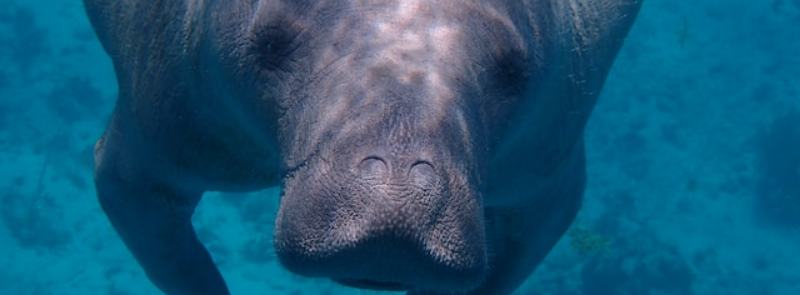
When It Occurs
Annually Last Wednesday In March
Official Website
Timeline
Days Passed (960)
# Hashtags
#ManateeAppreciationDay #MarineLife
The manatee, an aquatic creature weighing up to 1,100 pounds and often referred to as "sea cows," primarily subsists on a herbivorous diet. Unfortunately, these marine animals are facing challenges due to global warming and human activities. Hence, the significance of Manatee Appreciation Day, observed on the last Wednesday in March.
This day serves as an opportunity for people not only to gain knowledge about these remarkable animals but also to discover ways they can contribute to safeguarding them against the threats that jeopardize their existence.
What are Manatees?
-
Species:
- Manatees are large, slow-moving aquatic mammals that belong to the order Sirenia. There are three species of manatees:
- West Indian Manatee (Trichechus manatus): Found in the warm coastal waters of the southeastern United States, the Caribbean, and Central and South America.
- Amazonian Manatee (Trichechus inunguis): Native to the freshwater habitats of the Amazon Basin in South America.
- West African Manatee (Trichechus senegalensis): Inhabits rivers, estuaries, and coastal areas in West Africa.
- Manatees are large, slow-moving aquatic mammals that belong to the order Sirenia. There are three species of manatees:
-
Physical Characteristics:
- Manatees have a distinct appearance, with large, paddle-like tails, rounded bodies, and small, whiskered faces. They can grow up to 13 feet in length and weigh as much as 1,300 pounds. Manatees have a slow metabolism and typically move at a leisurely pace, although they can swim quickly in short bursts when necessary.
-
Diet:
- Manatees are herbivores, feeding primarily on aquatic plants such as seagrasses, algae, and water hyacinths. They play a crucial role in their ecosystems by maintaining the health of seagrass beds and other aquatic vegetation.
-
Habitat:
- Manatees are commonly found in shallow coastal waters, rivers, estuaries, and warm springs. They prefer warm water and often migrate to warmer areas during colder months. In Florida, manatees can be seen gathering around natural springs and power plant outflows during the winter to stay warm.
History and Purpose of Manatee Appreciation Day
-
Origins of the Day:
- The Manatee Appreciation Day likely emerged as part of broader conservation efforts to protect manatees and raise public awareness about their plight. The day is supported by various conservation organizations, including the Save the Manatee Club, which was founded in 1981 by singer Jimmy Buffett and former U.S. Senator Bob Graham.
-
Purpose:
- The primary purpose of Manatee Appreciation Day is to educate the public about manatees, the challenges they face, and the actions that can be taken to protect them. The day aims to foster appreciation for these unique marine mammals and to promote conservation efforts that will ensure their long-term survival.
Threats to Manatees
-
Boat Collisions:
- One of the most significant threats to manatees is boat collisions. Manatees often inhabit shallow waters where boats travel, and their slow-moving nature makes them vulnerable to being struck by propellers. Injuries from boat strikes can be fatal or lead to long-term health problems for manatees.
-
Habitat Loss:
- Coastal development, pollution, and changes in water quality have led to the loss of important manatee habitats, including seagrass beds and warm-water refuges. Habitat destruction can limit the availability of food and safe resting areas for manatees.
-
Cold Stress:
- Manatees are sensitive to cold water and can suffer from cold stress when water temperatures drop below 68°F (20°C). Cold stress can lead to a weakened immune system, increased susceptibility to disease, and even death. Climate change and changes in water flow patterns can exacerbate this threat.
-
Entanglement:
- Manatees can become entangled in fishing lines, crab traps, and other marine debris, leading to injuries or drowning. Entanglement in discarded fishing gear is a significant concern in areas where manatees and recreational or commercial fishing activities overlap.
-
Red Tide and Algal Blooms:
- Red tide and harmful algal blooms produce toxins that can be deadly to manatees. Ingesting contaminated seagrass or inhaling toxins while surfacing for air can lead to respiratory distress and death.
Conservation Efforts
-
Legal Protections:
- Manatees are protected under several U.S. laws, including the Marine Mammal Protection Act of 1972 and the Endangered Species Act of 1973. These laws prohibit the harassment, hunting, capturing, or killing of manatees and protect their habitats.
-
Save the Manatee Club:
- The Save the Manatee Club is a leading organization dedicated to manatee conservation. The club engages in advocacy, public education, habitat protection, and rescue and rehabilitation efforts. It also runs an adoption program to raise funds for manatee conservation.
-
Boat Speed Zones:
- To reduce the risk of boat collisions, speed zones have been established in areas known to be frequented by manatees. These zones require boaters to slow down, especially in shallow waters, to give manatees a better chance of avoiding collisions.
-
Rescue and Rehabilitation:
- Manatees that are injured, orphaned, or stranded are often rescued and taken to rehabilitation centers for medical care. Once they have recovered, they are released back into the wild. Organizations such as the Florida Fish and Wildlife Conservation Commission (FWC) and various marine mammal rescue centers play key roles in these efforts.
-
Public Education:
- Public education campaigns aim to raise awareness about the importance of manatee conservation and to encourage responsible behavior among boaters, fishermen, and coastal residents. Educational programs are often conducted in schools, nature centers, and through media outlets.
How to Celebrate Manatee Appreciation Day
-
Visit a Manatee Sanctuary or Park:
- If you live near a manatee habitat, consider visiting a sanctuary, park, or viewing area where you can observe manatees in their natural environment. Many locations offer educational programs and guided tours that provide insights into manatee behavior and conservation.
-
Support Manatee Conservation Organizations:
- Support organizations like the Save the Manatee Club or local wildlife conservation groups by donating, volunteering, or adopting a manatee. Your contributions can help fund rescue efforts, habitat protection, and public education programs.
-
Spread Awareness:
- Use social media to spread awareness about Manatee Appreciation Day and the importance of manatee conservation. Share facts, photos, and information about how others can get involved in protecting these gentle creatures.
-
Practice Responsible Boating:
- If you’re a boater, make sure to follow speed zone regulations in manatee habitats and keep an eye out for manatees while on the water. Slow down in shallow areas, and avoid disturbing resting or feeding manatees.
-
Participate in a Beach Cleanup:
- Help protect manatee habitats by participating in a beach or waterway cleanup. Removing trash and debris from the environment can reduce the risk of manatee entanglement and improve the overall health of aquatic ecosystems.
-
Educate Yourself and Others:
- Take the time to learn more about manatees, their behavior, and the challenges they face. Share your knowledge with friends, family, and your community to help raise awareness and inspire others to take action.
-
Watch Documentaries or Read Books About Manatees:
- There are many documentaries, books, and online resources that provide valuable information about manatees and their conservation. Watching a documentary or reading a book about manatees can deepen your understanding and appreciation of these animals.
Fun Facts About Manatees
-
Gentle Giants: Manatees are often referred to as "gentle giants" because of their large size and peaceful nature. They are slow-moving and spend much of their time grazing on aquatic plants.
-
Close Relatives: Manatees are closely related to elephants. Both animals have similar characteristics, such as prehensile lips (used to grasp food), and manatees even have vestigial nails on their flippers, reminiscent of elephant toenails.
-
Long Lifespan: Manatees can live for several decades, with some individuals known to live into their 60s.
-
Vocalizations: Manatees communicate with each other through vocalizations, including squeaks, chirps, and whistles. These sounds are often used between mothers and calves or during social interactions.
-
Low Metabolism: Manatees have a low metabolic rate, which is why they prefer warm waters and are sensitive to cold temperatures.
Conclusion
Manatee Appreciation Day is a day to celebrate and protect these gentle marine mammals, whose survival depends on the continued efforts of conservationists, governments, and the public. By learning about manatees, supporting conservation initiatives, and spreading awareness, you can help ensure that these beloved creatures remain a part of our natural world for generations to come. Whether through education, action, or simply taking a moment to appreciate manatees in their natural habitat, Manatee Appreciation Day offers a meaningful opportunity to contribute to the protection and preservation of these unique animals.


